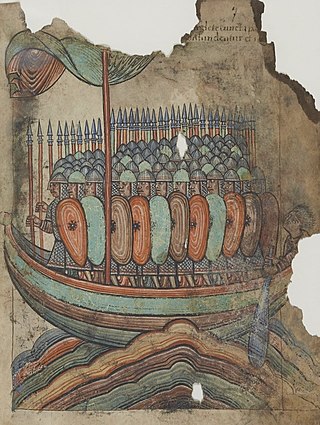The 810s decade ran from January 1, 810, to December 31, 819.

Year 851 (DCCCLI) was a common year starting on Thursday of the Julian calendar.

Lothair I was a 9th-century Carolingian emperor and king of Italy (818–855) and Middle Francia (843–855).

The Duchy of Brittany was a medieval feudal state that existed between approximately 939 and 1547. Its territory covered the northwestern peninsula of Europe, bordered by the Atlantic Ocean to the west, and the English Channel to the north. It was also less definitively bordered by the river Loire to the south, and Normandy, and other French provinces, to the east. The Duchy was established after the expulsion of Viking armies from the region around 939. The Duchy, in the 10th and 11th centuries, was politically unstable, with the dukes holding only limited power outside their own personal lands. The Duchy had mixed relationships with the neighbouring Duchy of Normandy, sometimes allying itself with Normandy, and at other times, such as the Breton–Norman War, entering into open conflict.

Nominoe or Nomenoe was the first Duke of Brittany from 846 to his death. He is the Breton pater patriae and to Breton nationalists he is known as Tad ar Vro.
Erispoe was Duke of Brittany from 851 to his death. After the death of his father Nominoe, he led a successful military campaign against the Franks, culminating in his victory at the Battle of Jengland. He is subsequently referred to as "King of Brittany".
Salomon was count of Rennes and Nantes from 852 and duke of Brittany from 857 until his assassination in 874. In 867, he was granted the counties of Avranches and Coutances, and he used the title king of Brittany intermittently after 868.

The history of Brittany may refer to the entire history of the Armorican peninsula or only to the creation and development of a specifically Brythonic culture and state in the Early Middle Ages and the subsequent history of that state.
Matfrid was the Frankish count of Orléans in the reign of Emperor Louis the Pious. He is usually thought to have been the first of the lineage known to historians as the Matfriede.
Morman was a Breton chieftain who was declared king (rex) after the death of the Bretons' Frankish overlord Charlemagne in 814. He is the first person known by name to be described as a Breton "king". He probably ruled a warband with members drawn from throughout Brittany. He had a stronghold defended by ditches, hedges and marshes.
The counts of Nantes were originally the Frankish rulers of the Nantais under the Carolingians and eventually a capital city of the Duchy of Brittany. Their county served as a march against the Bretons of the Vannetais. Carolingian rulers would sometimes attack Brittany through the region of the Vannetais, making Nantes a strategic asset. In the mid-ninth century, the county finally fell to the Bretons and the title became a subsidiary title of the Breton rulers. The control of the title by the Breton dukes figured prominently in the history of the duchy. The County of Nantes was given to Hoel, a disinherited son of a duke. He lost the countship due to a popular uprising. That uprising presented an opportunity for King Henry II of England to attack the Breton duke. In the treaty ending their conflicts, the Breton duke awarded the county to Henry II.
Lambert I was the Count of Nantes and Prefect of the Breton March between 818 and 831 and Duke of Spoleto between 834 and 836. Lambert succeeded his father Guy.
Lambert II was the Frankish Count of Nantes and Prefect of the Breton March between 843 and 851. Lambert ruled the county in opposition to Amaury, the puppet count installed by Charles the Bald, King of West Francia. At his death, the county was effectively in Breton control. Lambert was the son of Lambert I and his wife Itta.
The Battle of Jengland took place on 22 August 851, between the Frankish army of Charles the Bald and the Breton army of Erispoe, Duke of Brittany. The Bretons were victorious, leading to the signing of the Treaty of Angers in September 851 and the recognition of Erispoe as the legitimate ruler of the Bretons under Charles the Bald.
The Battle of Ballon took place on 27 March 845 between the forces of Charles the Bald, king of West Francia, and Nominoë, Duke of Brittany. Nominoë was appropriating border territory and opposing Charles' attempt to impose Frankish authority. Nominoë defeated Charles, initiating a period of Breton expansion and consolidation of power.
The Battle of Blain, also called the Battle of Messac, was fought on 24 May 843 by the forces of Lambert II of Nantes and Erispoe, prince of Brittany, against Renaud, Frankish Count of Nantes. It arose from Breton resistance to Frankish power within Brittany and disputes over control of the County of Nantes. The defeat of the Franks led to a period of Breton expansionism.

The Kingdom of Brittany was a short-lived vassal-state of the Frankish Empire that emerged during the Norse invasions. Its history begins in 851 with Erispoe's claim to kingship. In 856, Erispoe was murdered and succeeded by his cousin Salomon.
During the Battle of Roncevaux Pass a combined Basque-Qasawi Muslim army defeated a Carolingian military expedition in 824. The battle took place only 46 years after the first Battle of Roncevaux Pass (778) in a confrontation showing similar features: a Basque force engaging from the mountains, a northbound expedition led by the Franks, and the same geographical setting.

Vikings were active in Brittany during the Middle Ages, even occupying a portion of it for a time. Throughout the 9th century, the Bretons faced threats from various flanks: they resisted full incorporation into the Frankish Carolingian Empire yet they also had to repel an emerging threat of the new duchy of Normandy on their eastern border by these Scandinavian colonists.